Editor's Note: As of Aug. 1, 2020, NASA no longer refers to nebula NGC 2392 as the "Eskimo Nebula," as it can be considered an insensitive and offensive term. More information at: https://www.nasa.gov/feature/nasa-to-reexamine-nicknames-for-cosmic-objects.
Overview - Objectives
Ultraviolet Science
The UV spectral region is rich in information on the astrophysical properties of solar system objects, stars, star forming regions, and galaxies. The UV is uniquely sensitive to hot sources, in particular to the massive stars which are responsible for most "star-formation astrophysics," as well as to certain types of old, highly evolved, stars. This regime is also critical for studies of the metal abundances and surface gravities, two fundamental parameters of stellar astrophysics.
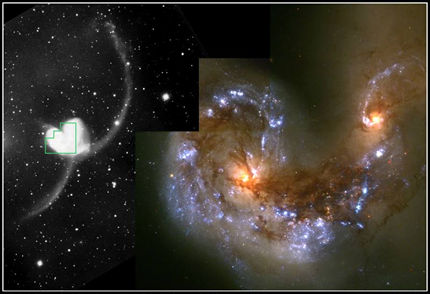
The Antennae Galaxies (NGC 4038/4039) imaged by WFPC2
The image shows the richness of star-forming regions (rich in hot, young stars visible in blue) and dust lanes present in this merger of two spiral galaxies. The bulges of the merging spirals contain older, colder stars and are visible in red.
STELLAR ARCHAEOLOGY
Resolved Stellar Populations
The study of star formation requires analysis of a large number of stars in wavelengths sensitive to temperature, metalicity, and gravity This will contribute significantly to our understanding of the birth of stellar populations. Old stars may have depleted their hydrogen fuel and begun burning Helium. These stars have surface temperatures above 10,000 K (the sun is near 6,000 K). They are faint in visible wavelengths, but shine brightly in the UV. WFC3 will allow detailed studies of these geriatric stars.
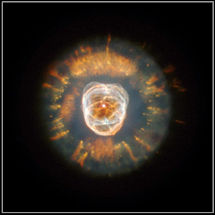
The Eskimo planetary nebula (NGC 2392) imaged by WFPC2
The nuclei of planetary nebulae are old stars that have lost their outer layers and emit most of their light at UV wavelengths. This UV radiation ionizes the ejected material, producing the bright nebula.
Stellar Populations in Integrated Light
Stellar populations at great distances may be too small to be seen individually, but WFC3 can collect the integrated light through different filters to determine much the same information, statistically, for a population as it can an individual star. The UV allows direct detection of the massive stars responsible for most of the ionization, photo-dissociation, kinetic-energy input, and element synthesis in galaxies. These processes are responsible for much of the astrophysics of the universe.
THE ASSEMBLY OF GALAXIES AT HIGH REDSHIFT
To analyze galaxies, we have to contend with redshift. According to Hubble's Law, the further away a galaxy is from us, the faster it is receding from us. The apparent speed of recession is quoted in units of the speed of light, c, so a galaxy with redshift 0.5 appears to be moving away from us at half the speed of light. At very high speeds, the spectra emitted by these galaxies are shifted to higher wavelengths (redder). This "redshift" moves diagnostic lines and makes them accessible to moderate UV detectors.
We now suspect that much of the “final assembly” of galaxies, and much of the conversion of primeval gas into stars, occurred at relatively low redshifts in the range z = 1-3. These redshifts correspond to lookback times of half to three-quarters of the present age of the Universe.
Star-forming galaxies produce an abundance of light around and below 912 Å (far ultraviolet). For small redshift (z=1-3), the light is shifted redward to 2000-3500 Å. The hydrogen Lyman-alpha emission line (1216 Å in the rest frame), is bright in many distant galaxies. For galaxies with redshifts of z = 0.8-3, this line can be detected in the 2000-5000 Å range.
Of special interest are the numerous "sub-galactic clumps," which make up a significant part of the faint blue galaxy population. Through the process of repeated hierarchical merging, it is believed that these clumps came together to form the luminous galaxies we see today, i.e. they are the building blocks of galaxies. If they exist everywhere, they may be used to trace the large scale structure of the Universe.
Download a PDF of a full review of WFC3's UV science objectives.
Near Infrared Science
Most astrophysical objects are not very bright in infrared. Stars and galaxies are too hot to emit much radiation here, but planets and other cool objects do. The near-infrared region is particularly interesting for cosmologists and astrophysicists studying some of the most distant and oldest objects in the universe, however. Although most objects radiate brightly at much lower wavelengths, extreme redshifting can move the lines from ultraviolet into the NIR.
The Highest-Redshift Galaxies
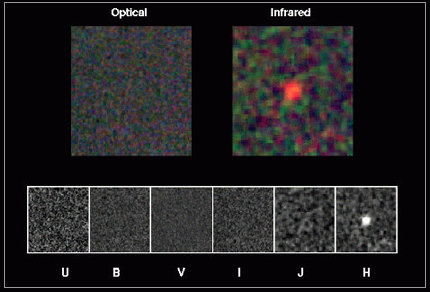
J-dropout object identified in the Hubble Deep Field North
This object is visible only in the NICMOS F160W (H) image. The U, B, V, and I images were obtained with WFPC2, the J and H images with NICMOS. Similar objects could be found in large numbers by WFC3 by searching a large area for sources bright in the H band and faint in the J band (M. Dickinson).
There are hundreds of thousands of faint, distant galaxies per square degree of sky. Many of these galaxies are so distant that they have significant redshifts. For redshifts above z=3 the bright Lyman region (912 Å up to 1216 Å) is shifted into the infrared. WFC3 will conduct NIR surveys of discovery to find these bright distant sources which date back to the very early universe.
Water and Ices on Mars and the Outer Planetary Satellites
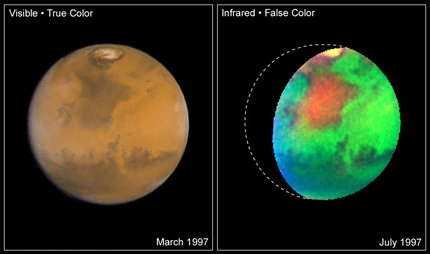
Water in Martian rocks as revealed by WFPC2 (left) and NICMOS (right)
The bluer shade along the edges of the Martian disk in the left panel is due to atmospheric haze and water ice clouds. The large reddish region in the right panel identifies an area of water-rich minerals known as Mare Acidalium.
The search for life on extraterrestrial planets is focused on the detection of water. A key indicator of water vapor is located at 1.4nm. Special filters on WFC3 are optimized for this region.. Other filters permit detection of a variety of ices , from H2O in the satellites of Jupiter and Saturn, to CH4 (Uranus) and CO and N2 (Neptune's Triton).
Download a PDF of a full review of WFC3's Near Infrared (NIR) science objectives.
Panchromatic Science
To obtain a whole, coherent picture of astrophysical phenomena, observations are needed in each of the UV, visible, and near-IR bands. Each band is affected differently by hot stars, cool stars, and dust. Many programs will take advantage of the panchromatic capabilities of WFC3.
Galactic Evolution
With multiband WFC3 exposures, astronomers will make important strides in understanding the astrophysical drivers of galaxy UV luminosities, the cosmic star-formation history over the past few billion years, and the nature of the strange systems detected at high redshifts.
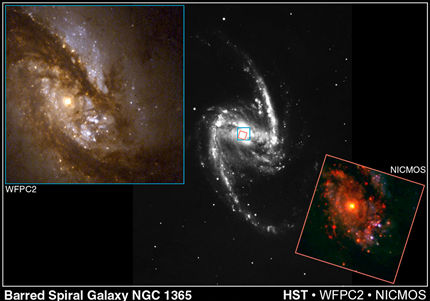
Images of the nearby spiral galaxy M81
2500 Å (left panel) and in the R band 6500 Å (right panel). The central bulge is dominated by cool main sequence and giant branch stars, and it progressively diminishes at shorter wavelengths. By contrast, hot OB associations in the spiral arms increase in brightness in the UV so that the arms stand out.
Star Birth, Death, and the Interstellar Medium
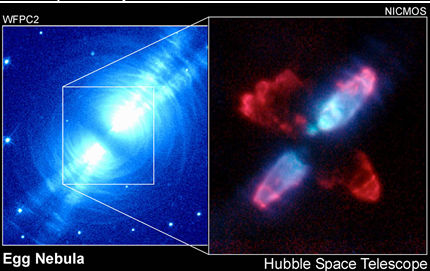
WFPC2 (left panel) and NICMOS (right panel) images of the Egg Nebula
The NICMOS image is color coded. The red features correspond to emission from hot ionized gas, the blue features to starlight reflected by dust.
Stellar Outflows
Both young and old stars eject material in the form of stellar winds. In some cases, the winds may coalesce into jets. Studying the physical, chemical, and ionization structures in these winds studies will allow us to connect the births of stars to their surroundings, and to see how dying stars stir up and enrich the inter-stellar medium
Initial Mass Function (IMF)
The IMF specifies the distribution in mass of a newly formed stellar population. Understanding how the mass is distributed may help us to understand the origin of the similarities and differences in the initial stellar mass function throughout the Milky Way and nearby galaxies.
Formation of Planetary Nebulae
As stars like our Sun die, they eject their outer layers. Occasionally, these ejections are violent and brilliant, forming novae or supernovae. The ejected material expands forming "planetary nebulae". WFC3's panchromatic cameras will provide much improved temperature, composition, and density probes of such planetary nebulae
Physical Structure of Galactic Nebulae
WFC3 will be used to investigate the small-scale ionization structure of Galactic nebulae. This includes the structure of ionization and shock fronts in H II regions, supernova remnants, and stellar outflows. Understanding the physics of these structures underlies interpretation of a wide range of astrophysical phenomena.
Starburst Galaxies and their Triggering Mechanisms
Some galaxies exhibit violent high-mass star formations called "starbursts". The triggering mechanisms of such unusual episodes are not understood. observations are needed into the ultraviolet (where the most massive stars formed in a starburst are observable) as well as into the infrared (where the youngest stars still swaddled in dust can be unveiled).
Meteorology of the Outer Planets
Most of the outer planets of our solar system are gaseous and have noticeable weather patterns and climatic variations. Due to their great distances, their orbital periods (or years) are very long (12 years for Jupiter, 30 for Saturn). Evolution of weather patterns requires monitoring over long timescales. Studying the weather on other planets will improve our knowledge of terrestrial weather by allowing meteorologists to refine their models.
Download a PDF of a full review of WFC3's panchormatic science objectives.


